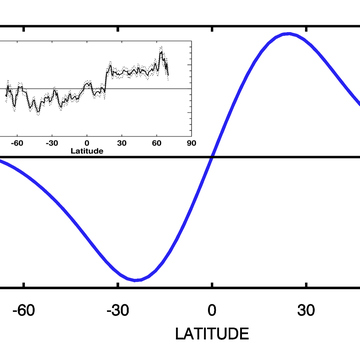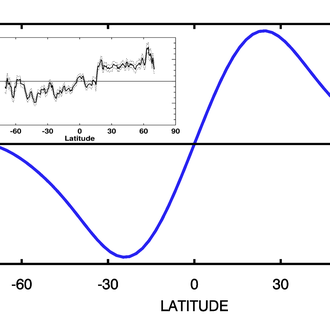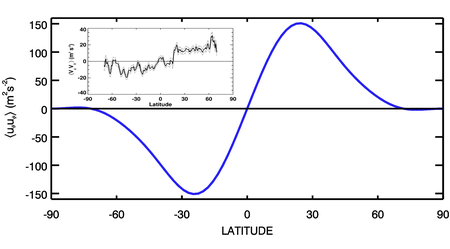The Lambda effect confirmed
Solar turbulence theory confirmed by solar observations: the Lambda effect exists. AIP theoreticians have long believed that turbulence on the Sun behaves opposite to what is known in classical experimental physics due to a complex mechanism taking place, called "Lambda Effect". A publication by Günter Rüdiger and colleagues in Astronomy & Astrophysics Letters comparing theory to observational data now concludes that this predicted effect indeed occurs on the Sun.
New computations of the horizontal Reynolds stress of the plasma in the (rotating) solar convection zone show it to be negative on the surface but positive in the bulk of the convection zone of the northern hemisphere (and opposite in the southern hemisphere). This is exactly what was discovered last year by the Helioseismic and Magnetic Imager onboard the Solar Dynamics Observatory (SDO).
The observed acceleration on the solar surface equator, commonly known as differential rotation, is generally believed to be produced by rotating turbulent convection, albeit the details of the physics behind it are very complex and yet to be fully understood. One of the problems was that such turbulences on the Sun appear to behave opposite to the turbulences in classical experimental physics. After Boussinesq (1897), all commonly known turbulence fields transport angular momentum towards the location of the slowest rotation rate. The Sun seems to violate this law and does it exactly in the opposite way. If indeed the solar turbulence is of non-Boussinesq type then all solar-type stars should possess accelerated equators with - as the AIP model calculations show - very similar lap-times, i.e. the time the equator finishes one rotation more than the poles. This was also recently shown to be the case by other space missions.
The formal reason for the non-Boussinesq character of solar (and likely also stellar) turbulence is the existence of the Lambda effect which dominates the angular momentum transport if the turbulence cells are huge and long-living (of the order of the solar rotation period). Numerical experiments showed that such huge cells transport angular momentum even for rigid rotation. Just recently, the Helioseismic and Magnetic Imager on board of the Solar Dynamic Observatory detected these giant solar turbulence cells with characteristic length scales of 100,000 km. And they indeed transport the angular momentum from the slow solar poles to the fast solar equator, i.e. opposite to the Boussinesq law. This finding represents the yet best evidence for the existence of the Lambda effect, which describes the angular momentum transport of rigidly rotating anisotropic turbulence, and thus improves our overall understanding of the basic phenomenon of plasma turbulence.
Publication: G. Rüdiger, M. Küker, & I. Tereshin 2014, “The existence of the Lambda effect in the solar convection zone as indicated by SDO/HMI data”, Astronomy & Astrophysics Letters, Volume 572, December 2014.
Science Contact: Prof. Dr. G. Rüdiger, gruediger@aip.de.
Solar turbulence theory confirmed by solar observations: the Lambda effect exists. AIP theoreticians have long believed that turbulence on the Sun behaves opposite to what is known in classical experimental physics due to a complex mechanism taking place, called "Lambda Effect". A publication by Günter Rüdiger and colleagues in Astronomy & Astrophysics Letters comparing theory to observational data now concludes that this predicted effect indeed occurs on the Sun.
New computations of the horizontal Reynolds stress of the plasma in the (rotating) solar convection zone show it to be negative on the surface but positive in the bulk of the convection zone of the northern hemisphere (and opposite in the southern hemisphere). This is exactly what was discovered last year by the Helioseismic and Magnetic Imager onboard the Solar Dynamics Observatory (SDO).
The observed acceleration on the solar surface equator, commonly known as differential rotation, is generally believed to be produced by rotating turbulent convection, albeit the details of the physics behind it are very complex and yet to be fully understood. One of the problems was that such turbulences on the Sun appear to behave opposite to the turbulences in classical experimental physics. After Boussinesq (1897), all commonly known turbulence fields transport angular momentum towards the location of the slowest rotation rate. The Sun seems to violate this law and does it exactly in the opposite way. If indeed the solar turbulence is of non-Boussinesq type then all solar-type stars should possess accelerated equators with - as the AIP model calculations show - very similar lap-times, i.e. the time the equator finishes one rotation more than the poles. This was also recently shown to be the case by other space missions.
The formal reason for the non-Boussinesq character of solar (and likely also stellar) turbulence is the existence of the Lambda effect which dominates the angular momentum transport if the turbulence cells are huge and long-living (of the order of the solar rotation period). Numerical experiments showed that such huge cells transport angular momentum even for rigid rotation. Just recently, the Helioseismic and Magnetic Imager on board of the Solar Dynamic Observatory detected these giant solar turbulence cells with characteristic length scales of 100,000 km. And they indeed transport the angular momentum from the slow solar poles to the fast solar equator, i.e. opposite to the Boussinesq law. This finding represents the yet best evidence for the existence of the Lambda effect, which describes the angular momentum transport of rigidly rotating anisotropic turbulence, and thus improves our overall understanding of the basic phenomenon of plasma turbulence.
Publication: G. Rüdiger, M. Küker, & I. Tereshin 2014, “The existence of the Lambda effect in the solar convection zone as indicated by SDO/HMI data”, Astronomy & Astrophysics Letters, Volume 572, December 2014.
Science Contact: Prof. Dr. G. Rüdiger, gruediger@aip.de.
Images
The horizontal Reynolds stress in theory (blue line) and observation (the insert)
Big screen size [1000 x 554, 90 KB]
Original size [2062 x 1144, 130 KB]





